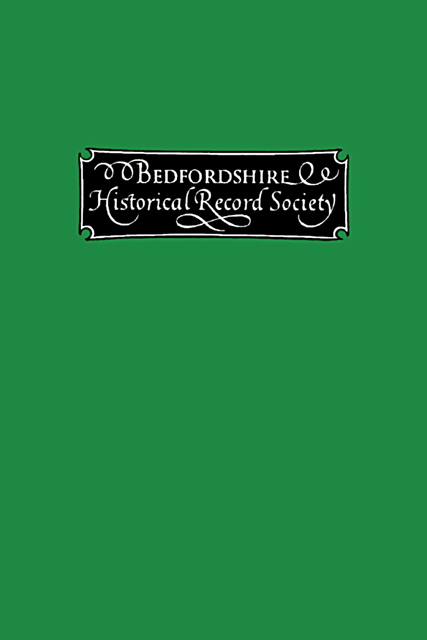Book contents
- Frontmatter
- Contents
- The Meeting-place of Wixamtree Hundred
- Two Cranfield Manors
- The Register of the Fraternity of St. John the Baptist, Dunstable, 1506-8, 1522-41
- Newnham Priory : a Bedford Rental, 1506-7
- Newnham Priory : Rental of Manor at Biddenham, 1505-6
- The Papers of Richard Taylor of Clapham, c. 1579-1641
- John Crook, 1617-1699 : a Bedfordshire Quaker
- A Bedfordshire Wage Assessment of 1684
- A Luton Baptist Minute Book, 1707-1806
- Miscellaneous Endmatter
- Index of Persons and Places
- Index of Subjects
- Miscellaneous Endmatter
- Maps
Two Cranfield Manors
Published online by Cambridge University Press: 18 July 2023
- Frontmatter
- Contents
- The Meeting-place of Wixamtree Hundred
- Two Cranfield Manors
- The Register of the Fraternity of St. John the Baptist, Dunstable, 1506-8, 1522-41
- Newnham Priory : a Bedford Rental, 1506-7
- Newnham Priory : Rental of Manor at Biddenham, 1505-6
- The Papers of Richard Taylor of Clapham, c. 1579-1641
- John Crook, 1617-1699 : a Bedfordshire Quaker
- A Bedfordshire Wage Assessment of 1684
- A Luton Baptist Minute Book, 1707-1806
- Miscellaneous Endmatter
- Index of Persons and Places
- Index of Subjects
- Miscellaneous Endmatter
- Maps
Summary
The main, manor of Cranfield was given to Ramsey Abbey by Alwyn the Black who died in 998, and it remained with the Abbey until the Dissolution. There were however two subsidiary properties which later are known as manors, and of which little account is given by the Victoria County History: Washingley, which is called a manor in 1515; Rudlandesfelde, so called in 1563. A group of over a hundred thirteenth and fourteenth century charters found at Winchester College throw light on both. These documents both supplement and are much fuller than a few related deeds in the Public Record Office.
WASHINGLEY MANOR
The family from which this manor took its name was a Huntingdonshire one. Walter of Washingley in 1166 held two parts of a knight’s fee in the Huntingdonshire parish of that name, and this estate appears to have been held by his descendants until the line ended with an heiress in 1392. Probably the William of Washingley who appears in Cranfield in the thirteenth century was a younger son of this family. The nearness of the Huntingdonshire parish to Ramsey Abbey, and the fact that the second William of Washingley was the Abbot’s steward seem to suggest that the first may have come to Cranfield in the Abbot’s service. He may equally have come independently.
In the Winchester charters the earliest are grants to William of Washingley and his wife Maud. There are thirteen of these, of which seven may be dated 1248-69, since they are witnessed by Maurice, vicar of Cranfield. Other witnesses are Geoffrey Rolond or Redlond, and William, son of Richer of Wroxhill, both members of the presenting jury for Redbornstoke Hundred in 1247. These charters show William of Washingley accumulating land. From Ralph Mareschal he acquired 27 strips and a plot of meadow, for which he paid sums varying from 4s. to 22s. in silver, with annual payments totalling 3d. for suit of court or other services. From Adam son of Geoffrey he had 7 strips (20s.; rent 2d.); rom Gilbert son of Walter 1 ac. (rent ½d.); from Richer of dourne and his son Walter 3 strips (1 mark; rent ½d.); from John of Olney 8 strips (2½ marks; rent ½d.).
- Type
- Chapter
- Information
- Publisher: Boydell & BrewerFirst published in: 2023

